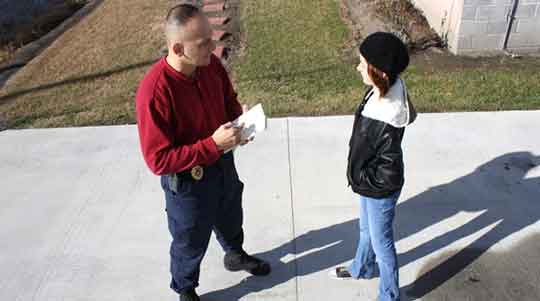I want us all to think back on situations we have found ourselves in and thought, “Wow, I could have easily been in a bad way if that guy would have wanted to attack.” We have all had times that we have made some pretty major tactical errors when it comes to dealing with contacts on the job. Some of us have even had times that we could have said, “But for the grace of God…”
Prior to the late 1980s, officers always equated being close with being in control. Nothing can be further from the truth. In fact, the closer you are to a suspect, the more dangerous that situation is for you. One of the most common mistakes officers make when conducting Field Interviews is the failure to realize the importance of maintaining adequate distance between them and the suspect being questioned.
A critical and important tactical skill we should always consider is the reactionary gap which can be defined as “the minimum amount of space needed to ensure that you can properly react to whatever threat may be presented by a suspect being questioned or detained.” We have to give ourselves enough space to be able to respond to an attack if a contact decides he is going to attempt to assault us.
The first concept to remember when considering the reactionary gap is the Interview Stance.
The Interview Stance was developed to ensure that officers performing field or street interviews position themselves close enough to speak to their subjects in a normal voice and be able to hear the subject’s responses, yet far enough away that they don’t become vulnerable to a physical attack. Remember, the basic elements of the interview stance are there to keep us safe and to give us every tactical advantage to conduct our business. Our full attention is on our contact, our body is positioned approximately 45 degrees, gun away, hands above our waist, and we have appropriate distance to respond.
Next, remember “police proxemics” defined as “the distance between an officer and the threat posed by certain weapons.” Here are some numbers to keep in mind:
• Firearms Threats: Generally your safety zone is defined as “line of sight unbroken by cover.”
• Edged Weapons: Generally a 20-25 foot zone of safety, depending on the circumstances and the level of the officer’s response. That distance could be more if you have information that the suspect may be skilled with EWs.
• Impact Weapons: Bludgeons, pipes, baseball bats, and the like require a minimum reactionary gap of 10-12 feet plus the length of the object — maybe more, depending on the circumstances.
• Empty Hands: For most empty-hand situations, you’re going to want at least a 5-6 foot reactionary gap between you and the subject you’re dealing with — maybe more, depending on your prior knowledge of the subject.
Always pay close attention to the suspect’s hands, demeanor, actions and keep in mind what brought us into contact with this person in the first place. Be constantly aware of your position and fix it immediately if you find yourself compromised. Stack the deck in your favor and keep that tactical edge at all times until the contact is complete. Going in to any situation involving having to deal with a potential violent attacker requires your undivided attention and a proper mindset.

